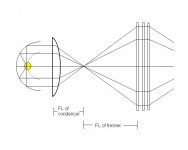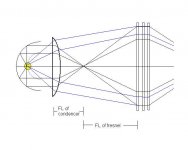I never said it was good... as a matter of fact I stated it was bad... all I'm saying is that if ace is positioning his bulb in the position he has it in his drawing... and he's using a spherical reflector... THE RAYS ARE NOT STRAIGHT!!!! I dont care if it can reflect 100% of the light... Period end of story!!!!!
I understand he spoke to some octical expert or whatever! Well if he did he misunderstood him!
I understand he spoke to some octical expert or whatever! Well if he did he misunderstood him!
lol u guys amaze me, are we going to talk about reflectors we are using for projection or are we going to talk solar collectors? just for the record cohort 36 is correct, the reflectors i have that are presision ground and polished are sperical reflectors and are engineered to reflect stait PARALELLE LIGHT RAYS ! and yess they are r/2 spec, typically the r/1 spec u would use for a solar collector, a small example, the reflector under a micro scope to colect light to the slide.
jcb
Grow up and post somthing useful, how about some proof on your theroys?
jcb
Grow up and post somthing useful, how about some proof on your theroys?
🙂 Proof... I've been working to put up my own site and sell the plans for my design. So you wont have to wait long for the proof big guy.
And once again... no, they are not!
And once again... no, they are not!
jcb
your ****ing crazy with your ways **** head grow up and learn somthing will ya read whats on the net
your ****ing crazy with your ways **** head grow up and learn somthing will ya read whats on the net
mikekniner said:I can't figure you guys out, Why the **** would you want the light reflected right back at the bulb? It would cook it, in my opinion ace is right unless you can prove otherwise.
Ask Dakane, Elmo, or 3M, they made their OHPs this way.
http://ourworld.compuserve.com/homepages/awi_industries/Optic_reflectors.htm
This provides all the info for you debate lol
This provides all the info for you debate lol
Reflector
I reuse this thread (good, isn't it).
Background: case ace_3000_1 vs. jcbklyny
Image 18wheeler posted.
I think 18wheelers theory works (I use that kind of reflector anc condencer too).
Anyway, you can also do it another way.
Background information from AWI.
If the light source is placed on the focal surface instead, the reflected light rays will be collimated. The focal surface is defined as a spherical surface with half the radius as the reflector.
I can imagine it like in the picture below. It's important also to calculate the distances right, also the diameter of reflector matters here. Focal surface is the grey half circle, btw.
I reuse this thread (good, isn't it).
Background: case ace_3000_1 vs. jcbklyny
Image 18wheeler posted.
I think 18wheelers theory works (I use that kind of reflector anc condencer too).
Anyway, you can also do it another way.
Background information from AWI.
If the light source is placed on the focal surface instead, the reflected light rays will be collimated. The focal surface is defined as a spherical surface with half the radius as the reflector.
I can imagine it like in the picture below. It's important also to calculate the distances right, also the diameter of reflector matters here. Focal surface is the grey half circle, btw.
Attachments
Also you can use parabolic reflector and put the bulp into the focal point of reflector to get collimated beam.
An externally hosted image should be here but it was not working when we last tested it.
Ok, for completeness the third option, an elliptical reflector.
Here you put the bulp in the first focal point, but you don't need condencer lens at all, just calculate where the light rays will hit the 1st fresnel and put it there (the fresnel). It depends on the reflector, the 2nd FP of it is a point from where the distance to fresnel should be the FL of the fresnel, but again it's not that simple to get max. light source.
An externally hosted image should be here but it was not working when we last tested it.
Here you put the bulp in the first focal point, but you don't need condencer lens at all, just calculate where the light rays will hit the 1st fresnel and put it there (the fresnel). It depends on the reflector, the 2nd FP of it is a point from where the distance to fresnel should be the FL of the fresnel, but again it's not that simple to get max. light source.
So the question is what is the best reflector for DIY projectors. I've got an old reflector from used lamp assembly from a Sharp (I think) pj (don't know the model, it's from local university). It's parabolic and does have a hole in bottom from where the lamp is installed. Problem is to find a bulp that could be fit there (maybe some Philips CMD bulps could do, a 150W is quite small in size). You could also use spherical with a hole in the middle, the problem is now to find appropriate bulps and reflectors that could be fit. The one I use now isn't bad, but the other where light doesn't come back to the source (or actually close to it) seem to gather more light, practically almost 100% (times the reflectivity of the reflector itself). The "bulp in focal point of spherical reflector" will loose at least 30-40% of the light.
How spherical reflectors REALLY work:
Spherical reflectors maximize illumination by increasing the light source efficiency of the bulb itself. The bulb is NOT placed at the focal point of the reflector or inside it (because you DONT want the light to reflect straight off the reflector).
Instead the arc of the bulb should be placed at the center of curvature. The center of curvature is exactly twice the distance of the focal point. So if your spherical reflector has a 50mm focal point, the arc would be placed at 100mm. The curvature is the size of the reflector and should be a little larger then the arc length of your bulb. This allows the condenser lens to collect more light from the arc and focus it towards the next optical element... in our case the fresnel lens.
Spherical reflectors maximize illumination by increasing the light source efficiency of the bulb itself. The bulb is NOT placed at the focal point of the reflector or inside it (because you DONT want the light to reflect straight off the reflector).
Instead the arc of the bulb should be placed at the center of curvature. The center of curvature is exactly twice the distance of the focal point. So if your spherical reflector has a 50mm focal point, the arc would be placed at 100mm. The curvature is the size of the reflector and should be a little larger then the arc length of your bulb. This allows the condenser lens to collect more light from the arc and focus it towards the next optical element... in our case the fresnel lens.
I second jcb, because I opened my dukane and looked at the position of the bulb and reflector. for anyone who worried about frying bulb, the temperature of arc is about 400-600 C according to the spec.
I will receive a 3M OHP this week. once I open it and look at the setup I will report here.
If you have time, go back and dig out an old post by YWH. It clearly stated the light should be reflected to the bulb to create a single point source.
I will receive a 3M OHP this week. once I open it and look at the setup I will report here.
If you have time, go back and dig out an old post by YWH. It clearly stated the light should be reflected to the bulb to create a single point source.
Yes, with collimated reflectors there is one problem I didn't though of first: with condencer lens they create a second point source which makes it impossible for the fresnel to collimate the light from the two point sources at the same time. So the collimated reflector will only work if it's large enough to cover the whole LCD panel area, and you will still need the fresnel to collimate the direct light from the bulb (fresnel lets collimated light go straight through). So with a spherical reflector either use the regular way (put the bulb in center of the sphere, not in the focal point) or use a very large spherical reflector and put the bulb in focal point of it. But wouldn't that latter reflector actually be better than the first one (though practically too expensive, for a 15" TFT you would need a spherical reflector with radius of 7.5", that would look cool though, wouldn't it)?
using 250w in a 400w ohp
is it ok to use a 250w bulb in a 400w ohp?
is it ok to do this like with house lights? in a high quality ohp with effeicient light refraction and reflection it may be good to have a option of medium bright bulb in the number 2 mounting.
would it be unwise to place different wattages in the two bulb mountings (these revovle on a switch), or do some dudes here do it already?
is it ok to use a 250w bulb in a 400w ohp?
is it ok to do this like with house lights? in a high quality ohp with effeicient light refraction and reflection it may be good to have a option of medium bright bulb in the number 2 mounting.
would it be unwise to place different wattages in the two bulb mountings (these revovle on a switch), or do some dudes here do it already?
Well, assuming you could even find a 250 w bulb that would fit in a 400w OHP(410w FXL I'm assuming), no. It would fry it. 400w to a 250w bulb = no-no. You could, however, install a dimmer switch to lessen the brightness, which in turn would lengthen bulb life.
- Status
- Not open for further replies.
- Home
- General Interest
- Everything Else
- The Moving Image
- DIY Projectors
- -IS- 250W enough or is 400W really really much better?

